![]()
Track Plans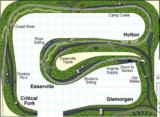 Interstate Track Plans Interstate Track Plans |
Photos | Models |
History
The Interstate Railroad is an 88 mile long coal-hauling shortline set in the hills of western Virginia. The IRR was incorporated on February 18, 1896 by the Virginia Coal and Iron Company to provide transportation of coal from several mines in Wise County, Virginia to the L&N at Appalachia. A few years later, a connection with the Virginia & Southwestern (later acquired by the Southern) also provided a southbound outlet for the excellent coking coal of the region. The railroad gradually spread east through acquisition and construction until it established a connection with the N&W at Norton in 1909 (Wolfe, p.17-21).
In 1923, the IRR completed its final stretch of mainline by establishing a connection with the CC&O (Clinchfield) at Miller Yard. In the 1930s, the L&N used trackage rights over this line (known as the Guest River Extension) to deliver its coal directly to the CC&O. In 1935, the IRR and L&N established a flat-rate per car arrangement that had the L&N drop-off its Clinchfield-bound loads at Dorchester Jct (just west of Norton) where the IRR would pick them up and deliver them to Miller Yard. The IRR trains performing this duty were known as “Hill Crews.” This arrangement lasted all the way til 1973 (p.37).
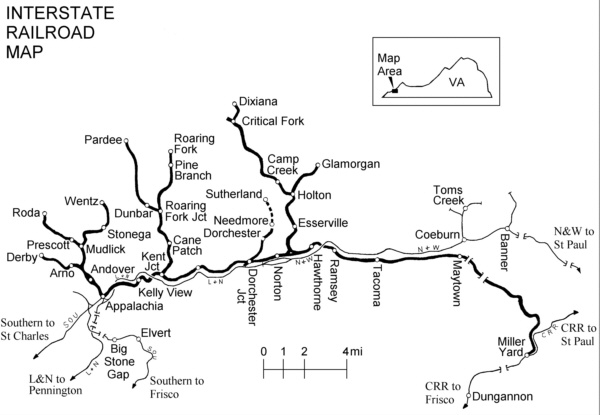 The Interstate made its money in two ways. First, it made money by delivering on-line coal from the mines to interchange points. Secondly, it made money through per-diem charges on its large hopper fleet. Every night at midnight, a record is made of where each revenue car is located. The railroad holding the car is charged a small per-diem fee to be paid to the owner of the car. Interstate crews prided themselves on their “per-diem prudence.” If a foreign-road car was needed to load coal, it was placed in a first-out spot at the tipple. That way, the car would be loaded and placed onto another railroad long before midnight. Likewise, if the L&N or Clinchfield delivered a string of cars for the Interstate to shuttle at 11:00 PM, the IRR would immediately dispatch a crew to move the cars down the line and off IRR rails to stick the charges to someone else. By managing per-diem charges and ensuring IRR cars spent much of their time making money off-line, the IRR kept its books in the black almost every year.
The Interstate made its money in two ways. First, it made money by delivering on-line coal from the mines to interchange points. Secondly, it made money through per-diem charges on its large hopper fleet. Every night at midnight, a record is made of where each revenue car is located. The railroad holding the car is charged a small per-diem fee to be paid to the owner of the car. Interstate crews prided themselves on their “per-diem prudence.” If a foreign-road car was needed to load coal, it was placed in a first-out spot at the tipple. That way, the car would be loaded and placed onto another railroad long before midnight. Likewise, if the L&N or Clinchfield delivered a string of cars for the Interstate to shuttle at 11:00 PM, the IRR would immediately dispatch a crew to move the cars down the line and off IRR rails to stick the charges to someone else. By managing per-diem charges and ensuring IRR cars spent much of their time making money off-line, the IRR kept its books in the black almost every year.
By the late 1950s, the Interstate’s fleet of 50 ton hoppers were growing old and obsolete. Rather than face the task of acquiring a new hopper fleet, the Interstate was put-up for sale. Both the L&N and Southern placed bids worth over $15 million. On the day of the sale, the difference between the two bids was less than $25,000, but the Southern won, and ownership was transferred in October of 1960 (p.52).
From 1960 until 1965, things were status-quo on the Interstate, but on September 10, 1965, the Southern shut down its Appalachia yard and moved into Andover (p.53). The Interstate’s bright RS3s were soon moved South to work as yard engines to work in major Southern cities like Atlanta.
At first, the Southern used old F-units on Interstate mine runs, but in the late 60s, the Southern invested heavily in GP38s for use on the Interstate’s branch lines. An enormous transloading facility was built on top of the ex-Southern yard at Appalachia by Westmoreland coal. This facility became the terminus for many single car loadings from Interstate tipples. These short-haul cars were known as “yellow balls” and were generally smaller, older 50 and 70 ton hoppers. The transloader and a few other loaders like Wentz became loading points for unit trains, a concept the Southern helped inspire.
When the energy crisis and subsequent coal boom of the 70s hit, the Interstate was not prepared to handle the onslaught of new traffic. An early victim was the agreement with the L&N for haulage of coal to the Clinchfield. The L&N, feeling its traffic was receiving too low a priority, entered into a trackage rights agreement with the N&W on June 5th, 1973 (p.56). The agreement allowed the L&N to run trains on the N&W’s line through Norton to St Paul to interchange with the Clinchfield at Castle Yard. The Interstate line between Ramsey and Miller Yard was then used mainly for Plate “C” or larger cars which would not fit through the tight N&W tunnels. It was abandoned in 1985 (p56).
The next major change for the Interstate came in 1982 with the merger of the Southern and N&W into Norfolk Southern. Although operations changed little in the beginning, by the mid-80s, change was in full-swing. The Interstate ceased to exist as a separate entity on October 31st, 1985 when control was transferred to the Clinch Valley Extension of the Pocahontas Division (p.59,60). Soon after, in January 1986, the L&N (CSX) no longer exercised its trackage rights over the N&W line through Norton. Instead, the CSX and NS had arranged an agreement that allowed CSX trains to use the Southern’s line south of Big Stone Gap. In exchange, the NS used the ex-CRR line from St Paul to Frisco for most of its South-bound coal (Flanary, p.41).
Andover yard is still an important coal-collection point on the ex-Interstate, but only for the western IRR branches. The ex-N&W yard at Norton now serves as the primary collection point for the eastern branches. The ex-L&N line from Big Stone Gap to Norton was sold to local coal companies, and after years of collecting rust, a loadout has been constructed east of Appalachia over the old L&N main. The CSX is fighting hard for the rights to serve the loader, so gray and black may once again compete in Appalachia!
Coal Lines and Operations
The Interstate served dozens of tipples on four branchlines and a few along the mainline. The four major branches were the Roda Branch, the Roaring Fork Branch, the Dorchester Branch, and the Glamorgan Branch.
Roda Branch. The Roda Branch was served by the Fourth and Fifth mine runs and was home to the following loaders during the 60s-80s: Crossbrook, Derby, Prescott, Osaka #2, Roda, Stonega, and Wentz.
Roaring Fork Branch. The Roaring Fork Branch was served by the Second mine run and had the following loaders: Cane Patch, Pine Branch, Clark Siding, Whitfield Siding, Band Mill Siding, and Pardee.
Dorchester Branch. The Dorchester Branch housed only the Dorchester Tipple by the 60s and was served by the First or Second Hill crew.
Glamorgan Branch. The Glamorgan Branch was served by the First and Third mine runs and later by the Second Hill crew and had the following loaders: Hood, Esserville Scale Siding, Bruton’s Siding, Roys Siding, Esserville Tipple, Holton, Glamorgan, Camp Creek, Critical Fork, Dixiana #1, and Dixiana #2.
Mainline. Loaders on the mainline (probably served by the hill crews) included Blackwood #1, Blackwood #2, Hawthorne, and Ramsey.
A few non-coal industries were also scattered accross the line. Virginia Wholesale received supplies on two spurs: one in Appalachia and the other in-between Arno Wye and Mudlick Jct. Central Supply received supplies from a spur at Arno Wye. Hamer Lumber Company was located near Kelly View and loaded lumber and wood products. Virginia Supply received supplies from a spur just north of Norton on the Glamorgan branch, and Austin Powder received covered hoppers full of ammonium nitrate at Holton.
Interchanges were located at Appalachia (L&N and Southern), Dorchester Jct (L&N), Norton (L&N and N&W), and Miller Yard (Clinchfield).
On an average day, the mine runs would collect loads and place empties at the tipples. Loads would be collected at Andover, and yard crews would make-up trains for interchange. The hill crews handled all movements between Andover and Miller Yard. They were extremely important in the 60s because they delivered all of the coal between the L&N and the Clinchfield. In later years, hill crews switched loaders along the mainline and handled N&W and CRR interchange traffic.
Interstate Railroad Diesel Roster:
| Number | Type | Date | Disposition |
| 30 | RS3, ph III | 11/53 | Retired 74 |
| 31 | RS3, ph III | 11/53 | Retired 76 |
| 32 | RS3, ph III | 11/53 | Retired 74 |
| 33 | RS3, ph III | 11/53 | Retired 76 |
| 34 | RS3, ph III | 11/53 | Wrecked 73, Retired 74 |
| 35 | RS3, ph III | 11/53 | Retired 76 |
| 36 | RS3, ph III | 11/53 | Retired 74 |
| 37* | RS3, ph III | 8/52 | Retired 70 |
| 38 | RS3, ph III | 1/56 | Retired 74 |
| 39 | RS3, ph III | 1/56 | Retired 74 |
*ex-Alco Demonstrator #1607
Related Products:
Sources:
- Wolfe, Ed. The Interstate Railroad. Old Line Graphics.
- Flanary, Ron. L&N Cumberland Valley Division Album 1945-1985. Old Line Graphics




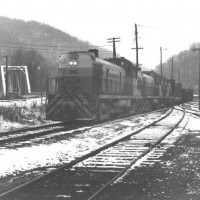 Interstate Photos Page
Interstate Photos Page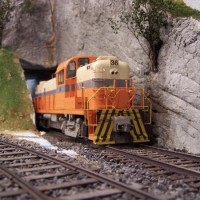 Interstate Models Page
Interstate Models Page

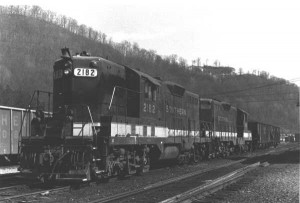
Pingback: Two Key Questions for Track Plan Compression – Derby, VA Case Study – Appalachian Railroad Modeling
I my name is Jake hash and I would like to know where the Appalachia, Andover, Norton and Miller yard layout is?
Jake, unfortunately this one (along with most on this site) is just a track plan. I share these ideas to inspire others with ideas for their own layout spaces. Anyone who takes this one on is definitely a big dreamer with a lot of space!